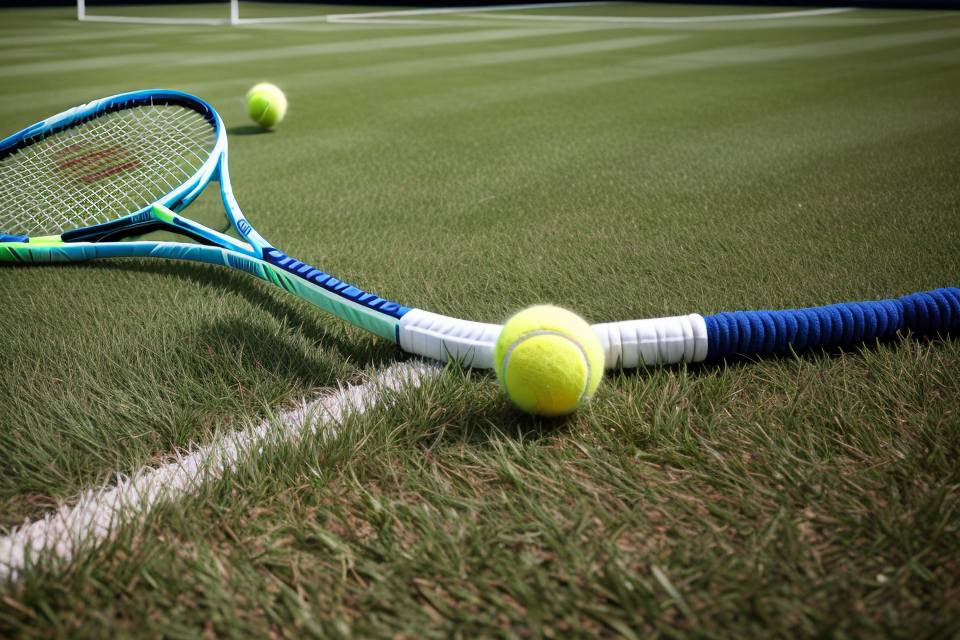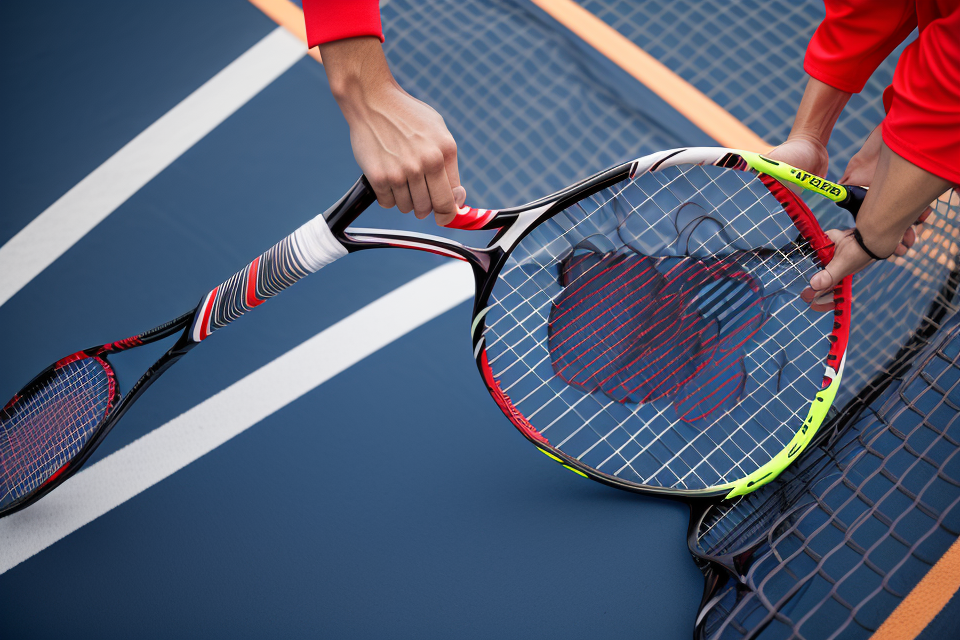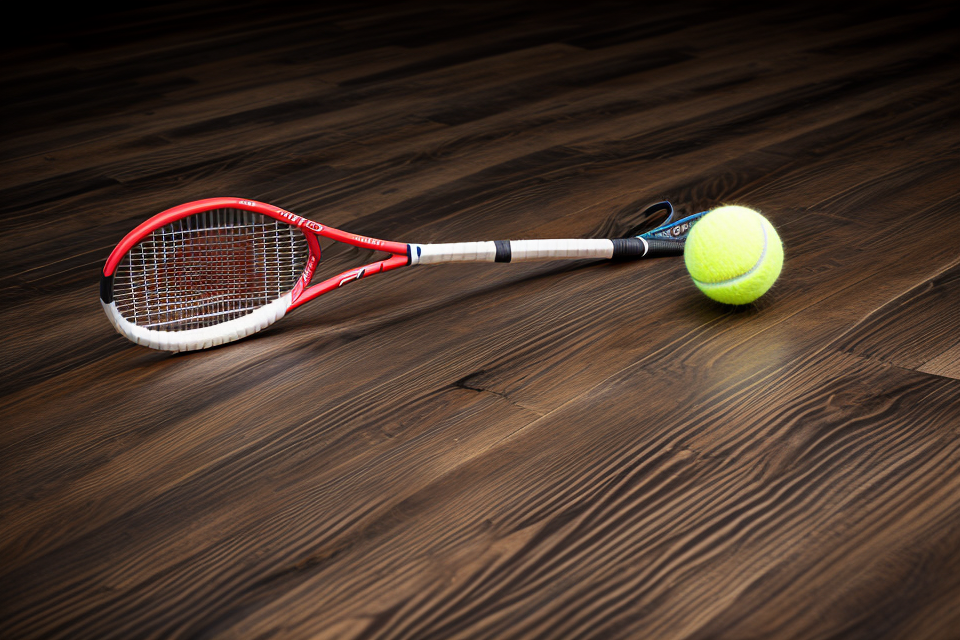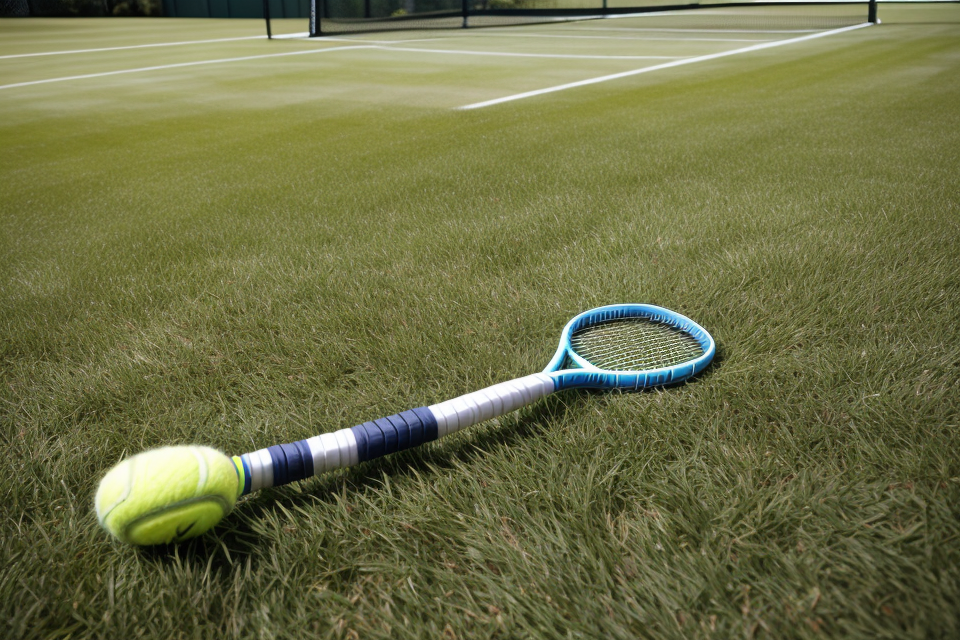The life of a tennis court can vary depending on various factors such as usage, maintenance, and weather conditions. In this guide, we will explore the factors that affect the longevity of a tennis court and provide tips on how to maintain it for optimal performance. Whether you’re a professional player or a casual enthusiast, understanding the life of a tennis court is crucial to ensuring a great playing experience. So, let’s dive in and discover the secrets to keeping your tennis court in top shape!
Factors Affecting the Life of a Tennis Court
Surface Type
Concrete
Advantages
- Durability
- Resistance to weather conditions
- Low maintenance costs
Disadvantages
- Difficult to repair
- Expensive upfront cost
- Cracking and surface wear
Acrylic
- Faster drying time
- Better shock absorption
-
Easy to repair
-
Higher maintenance costs
- May be affected by extreme weather conditions
- Yellowing over time
Durability
A concrete tennis court is known for its durability, which can last for several years if properly maintained. The hard surface can withstand heavy use and extreme weather conditions, making it a popular choice for tennis facilities.
Resistance to weather conditions
Concrete tennis courts are also resistant to weather conditions, such as rain and snow, which can cause damage to other types of surfaces. This resistance makes it easier to maintain the court and ensures that it remains in good condition throughout the year.
Low maintenance costs
Compared to other types of surfaces, concrete tennis courts have low maintenance costs. The hard surface requires less frequent cleaning and resurfacing, which helps to reduce the overall cost of maintenance.
Difficult to repair
One of the main disadvantages of a concrete tennis court is that it can be difficult to repair. Cracks and other types of damage can be difficult to fix, which can result in costly repairs.
Expensive upfront cost
Concrete tennis courts can be expensive to install, which can be a barrier for some tennis facilities. The upfront cost can be a significant investment, but the long-term durability of the surface can help to offset this cost over time.
Cracking and surface wear
Over time, concrete tennis courts can experience cracking and surface wear. This can be caused by heavy use, extreme weather conditions, or poor maintenance. Cracking and surface wear can affect the performance of the court and may require repairs to maintain its integrity.
Faster drying time
An acrylic tennis court has a faster drying time than a concrete court. This means that the court can be used more frequently, which can be beneficial for tennis facilities that are busy with multiple matches and practices.
Better shock absorption
Acrylic tennis courts also provide better shock absorption than concrete courts. This can help to reduce the risk of injury for players, as the surface is more forgiving on joints and feet.
Easy to repair
One of the main advantages of an acrylic tennis court is that it is easy to repair. Damage such as cracks and holes can be filled in easily, which can help to reduce the overall cost of maintenance.
Higher maintenance costs
While acrylic tennis courts have lower upfront costs than concrete courts, they have higher maintenance costs over time. The surface may require more frequent cleaning and resurfacing, which can add up over time.
May be affected by extreme weather conditions
Acrylic tennis courts may be affected by extreme weather conditions, such as heat and sunlight. This can cause the surface to yellow or become brittle, which can affect the performance of the court.
Yellowing over time
Over time, acrylic tennis courts may yellow or become discolored. This can be caused by exposure to sunlight or other environmental factors. While this does not affect the performance of the court, it can be a cosmetic issue that may require periodic maintenance.
Weather Conditions
UV Rays
Effects on Tennis Courts
Ultraviolet (UV) rays from the sun can have a significant impact on the longevity and condition of a tennis court. Over time, exposure to UV rays can cause various issues, including fading of court markings, degradation of the court surface, cracking and weathering, increased maintenance costs, and a shortened lifespan.
Fading of court markings
Constant exposure to UV rays can cause the lines on a tennis court to fade over time. This can make it difficult for players to see the boundaries and affect the accuracy of their shots.
Degradation of court surface
UV rays can also cause the surface of a tennis court to degrade, leading to uneven surface and compromised playing conditions. This can lead to safety issues for players and affect the overall quality of the game.
Cracking and weathering
Exposure to UV rays can cause the surface of a tennis court to crack and weather over time. This can result in the formation of potholes and other hazards that can cause injuries to players.
Increased maintenance costs
Maintaining a tennis court that has been exposed to UV rays for an extended period can be expensive. Repairs and resurfacing may be required more frequently, which can lead to increased maintenance costs over time.
Shortened lifespan
Exposure to UV rays can significantly shorten the lifespan of a tennis court. Without proper maintenance and protection, a tennis court can become unsafe and unusable within a few years.
Prevention and Mitigation
To prevent or mitigate the effects of UV rays on a tennis court, it is essential to implement proper maintenance and protection measures. Some effective strategies include:
Regular cleaning and maintenance
Regular cleaning and maintenance can help remove dirt and debris that can accumulate on the court surface and cause damage. This can include regular sweeping, washing, and repairing of the court.
Use of UV-resistant court surfaces
Installing a UV-resistant surface on a tennis court can help protect it from the harmful effects of UV rays. This can include using specialized coatings or surfacing materials that are designed to resist UV damage.
Installation of shade structures or covers
Installing shade structures or covers can help protect a tennis court from excessive exposure to UV rays. This can include installing shade sails, canopies, or other structures that can provide shade and reduce exposure to harmful UV rays.
Regular resurfacing and repairs
Regular resurfacing and repairs can help maintain the condition and safety of a tennis court. This can include repaving, repainting, and repairing any damage to the court surface.
Traffic and Usage
High Traffic Areas
High traffic areas on a tennis court can have a significant impact on its longevity. These areas include the service line, the net area, and the doubles alley. The constant pounding of feet and the repetitive hitting of balls in these areas can cause accelerated wear and tear, leading to cracks, divots, and other types of damage.
The effects of high traffic areas on a tennis court can be significant. The constant use of these areas can lead to a reduced lifespan for the court, as well as increased maintenance needs. Over time, the surface of the court may become uneven, and the playing characteristics may change, making it more difficult for players to maintain their accuracy and control.
Preventing and mitigating the effects of high traffic areas on a tennis court requires a proactive approach to maintenance. One way to reduce the impact of high traffic areas is to schedule and rotate court usage, ensuring that each area of the court is used evenly over time. Regular maintenance and repairs can also help to prevent damage from becoming too severe. In cases where damage is already present, resurfacing or resurfacing may be necessary to restore the playing characteristics of the court.
Overall, it is important to recognize the impact that high traffic areas can have on a tennis court’s longevity. By taking a proactive approach to maintenance and making necessary repairs, it is possible to extend the life of the court and ensure that it remains safe and enjoyable for players of all skill levels.
Tennis Court Maintenance and Longevity
Importance of Regular Maintenance
Regular maintenance is crucial to the longevity and performance of a tennis court. Neglecting regular maintenance can lead to a deterioration in the playing surface, which can be hazardous to players and result in costly repairs.
Advantages
Extends lifespan of the court
A well-maintained tennis court can last up to three times longer than one that is not regularly maintained. This means that regular maintenance can save money in the long run by reducing the need for costly repairs and resurfacing.
Improves playing surface
Regular maintenance ensures that the playing surface remains consistent and even, which is essential for a high-quality playing experience. This includes regular sweeping, cleaning, and marking of the court, as well as ensuring that the playing surface is free from debris and potholes.
Reduces maintenance costs over time
Regular maintenance can help reduce the overall cost of maintaining a tennis court. Neglecting regular maintenance can result in more frequent and costly repairs, as well as a shorter lifespan for the court.
Ensures safety for players
Regular maintenance helps to ensure that the playing surface is safe for players. This includes ensuring that the playing surface is free from debris and potholes, as well as maintaining the correct level of moisture to prevent slips and falls.
Maintains aesthetic appeal
Regular maintenance helps to maintain the aesthetic appeal of a tennis court. This includes cleaning and marking the court, as well as ensuring that the fencing and surrounding areas are also well-maintained. A well-maintained tennis court can enhance the overall appearance of a facility and attract more players to use it.
Best Practices for Tennis Court Maintenance
Regular Cleaning and Upkeep
Duties and Responsibilities
The responsibilities for regular cleaning and upkeep of a tennis court can be divided among several stakeholders, including:
- Court cleaning staff: These individuals are responsible for the day-to-day maintenance of the court, including sweeping, picking up debris, and washing the court.
- Maintenance personnel: These individuals are responsible for more specialized tasks, such as repairs and resurfacing.
- Club or facility management: These individuals are responsible for ensuring that the court is properly maintained and that any necessary repairs or resurfacing are carried out in a timely manner.
- Tennis players: While not responsible for the day-to-day maintenance of the court, tennis players can help by reporting any issues they notice to the club or facility management.
Importance of Regular Cleaning and Upkeep
Regular cleaning and upkeep is essential for maintaining the playability and aesthetic appeal of a tennis court. Without proper maintenance, a court can become slippery, bumpy, and unsightly, which can negatively impact the playing experience for both recreational and professional players.
Equipment and Tools Needed
To maintain a tennis court, the following equipment and tools may be needed:
- Brooms and sweepers
- Pressure washers
- Mops and cleaning solutions
- Scrapers and patching materials
- Repair materials, such as crack filler and paint
Proper Techniques and Procedures
Proper techniques and procedures for regular cleaning and upkeep of a tennis court may include:
- Sweeping or blowing off the court after each use
- Washing the court with a pressure washer and cleaning solution at least once a week
- Repairing any cracks or potholes as soon as they appear
- Repainting the court every few years, as needed
Repair and Resurfacing
When to Repair or Resurface
There are several signs that may indicate that a tennis court needs repair or resurfacing, including:
- Wear and tear, such as cracks, potholes, or fading paint
- Safety concerns, such as slippery or uneven surfaces
- Playability issues, such as bounces that are too low or too high
- Aesthetic concerns, such as a court that is unsightly or unappealing
- Maintenance needs, such as a court that requires frequent repairs or resurfacing
- Budget and financial considerations, such as the cost of repairs or resurfacing versus the cost of a new court
- Compliance with regulations and standards, such as the need to meet certain safety or performance standards
- Timing and scheduling, such as the need to schedule repairs or resurfacing during off-peak hours to minimize disruption to players
Risks and Benefits of Repair or Resurfacing
Repairing or resurfacing a tennis court can have several benefits, including:
- Improved playability and safety
- Extended longevity of the court
- Enhanced aesthetic appeal
- Compliance with regulations and standards
However, there are also risks to consider, such as the cost of repairs or resurfacing, the potential for disruption to players, and the need to properly schedule and execute the work to ensure a successful outcome.
Proper Techniques and Procedures
Repair Techniques
Effective repair techniques for a tennis court may include:
- Crack repair: Using crack filler to fill in any cracks or fissures in the surface of the court.
- Pothole repair: Filling in any potholes or depressions in the surface of the court.
- Resurfacing: Removing the old surface of the court and applying a new layer of surface material, such as
Extending the Life of a Tennis Court
Extending the life of a tennis court requires a combination of best practices that promote longevity and optimal performance. These practices are aimed at preventing premature deterioration, ensuring compliance with regulations and standards, and maximizing the use of the court. Here are some of the best practices for extending the life of a tennis court:
Proper design and construction
Proper design and construction are critical in ensuring that the tennis court is built to last. The court should be designed to meet the appropriate standards and regulations, and the construction materials and techniques should be of high quality. This includes using materials that are durable, weather-resistant, and provide adequate drainage. Additionally, the court should be built on a stable base that can support the weight and usage of the court.
Regular maintenance and upkeep
Regular maintenance and upkeep are essential in extending the life of a tennis court. This includes cleaning the court regularly to remove dirt, debris, and other materials that can damage the surface. The court should also be resurfaced periodically to remove any wear and tear and restore the playing surface to its original condition. Resurfacing should be done before the court becomes unsafe or unplayable.
Timely repairs and resurfacing
Timely repairs and resurfacing are critical in maintaining the safety and performance of the tennis court. Repairs should be done promptly to address any damage or wear and tear that may occur. This includes fixing cracks, holes, and other damage to the surface of the court. Resurfacing should also be done promptly to prevent further deterioration and maintain the safety and performance of the court.
Use of high-quality materials and equipment
Using high-quality materials and equipment is essential in extending the life of a tennis court. This includes using materials that are durable, weather-resistant, and provide adequate drainage. Additionally, the equipment used for maintenance and upkeep should be of high quality and designed for the specific needs of the court. Using high-quality materials and equipment can help prevent damage and extend the life of the court.
Compliance with regulations and standards
Compliance with regulations and standards is crucial in ensuring that the tennis court is built and maintained to last. This includes complying with local, state, and federal regulations and standards for tennis courts. Compliance with these regulations and standards can help prevent damage and ensure that the court is safe for use.
Professional expertise and advice
Professional expertise and advice can be valuable in extending the life of a tennis court. This includes seeking advice from professionals who specialize in tennis court construction and maintenance. These professionals can provide valuable insights and advice on how to maintain and extend the life of the court. Additionally, seeking professional expertise can help ensure that the court is built and maintained to meet the appropriate standards and regulations.
Proper storage and handling of equipment and supplies
Proper storage and handling of equipment and supplies are important in maintaining the life of a tennis court. This includes storing equipment and supplies in a dry, safe location to prevent damage and deterioration. Additionally, equipment and supplies should be handled carefully to prevent damage and extend their lifespan.
Adequate budget and financial planning
Adequate budget and financial planning are critical in maintaining and extending the life of a tennis court. This includes allocating sufficient funds for maintenance and upkeep, repairs, and resurfacing. Additionally, financial planning should include contingencies for unexpected repairs or maintenance needs.
Education and training for maintenance personnel
Education and training for maintenance personnel are important in maintaining and extending the life of a tennis court. This includes providing training and education on proper maintenance techniques, safety procedures, and best practices for extending the life of the court. Additionally, education and training can help ensure that maintenance personnel are
Final Thoughts and Recommendations
As we come to the end of our comprehensive guide to tennis court maintenance and longevity, it’s important to reiterate the key takeaways and provide some recommendations for ensuring that your tennis court remains in top condition for as long as possible.
First and foremost, it’s essential to understand that the lifespan of a tennis court is highly dependent on the level of maintenance it receives. Regular cleaning, sweeping, and maintenance tasks can significantly extend the lifespan of your court, while neglecting these tasks can result in costly repairs or even the need for a full resurfacing.
Additionally, it’s important to be mindful of the type of tennis court surface you choose. While acrylic surfaces may be more durable and resistant to wear and tear, they may not provide the same level of performance as other types of surfaces. Conversely, synthetic grass courts may be more prone to wear and tear, but they can be more forgiving on players’ joints.
Ultimately, the best way to ensure the longevity of your tennis court is to invest in regular maintenance and repair tasks, and to work with a professional tennis court construction company to choose the right surface for your needs. By taking these steps, you can enjoy your tennis court for years to come, without worrying about costly repairs or replacements.
Call to Action
Maintaining a tennis court is crucial to ensure its longevity and prevent premature deterioration. The frequency and type of maintenance required will depend on factors such as the surface type, climate, and usage levels.
To get the most out of your tennis court, it is recommended to follow a regular maintenance schedule that includes regular sweeping, cleaning, and repairs. This will help to prevent damage from wear and tear, and ensure that the court remains safe and playable for as long as possible.
Additionally, it is important to keep an eye out for any signs of damage or wear and tear, and address them promptly to prevent them from becoming bigger problems down the line. This may include fixing cracks, resurfacing the court, or replacing worn-out materials.
By following these guidelines, you can help to extend the lifespan of your tennis court and enjoy many years of high-quality play.
Additional Resources
- The Tennis Court Construction Guide: This guide provides detailed information on the construction of tennis courts, including the materials and techniques used to build them. It also includes information on the different types of surfaces available for tennis courts and their pros and cons.
- The Tennis Court Maintenance Manual: This manual provides a comprehensive guide to maintaining tennis courts, including tips on how to maintain different types of surfaces, how to repair and resurface courts, and how to deal with common problems such as cracks and potholes.
- The Tennis Court Resurfacing Guide: This guide provides information on how to resurface tennis courts, including the different types of resurfacing options available, the costs involved, and the steps involved in the process.
- The Tennis Court Equipment Guide: This guide provides information on the equipment needed to maintain and resurface tennis courts, including the tools and materials required for each task.
- The Tennis Court Drainage Guide: This guide provides information on how to properly drain tennis courts to prevent water damage and ensure that the court is playable year-round.
- The Tennis Court Lighting Guide: This guide provides information on how to properly light tennis courts to ensure that they are safe and playable at night.
- The Tennis Court Accessories Guide: This guide provides information on the accessories needed to complement a tennis court, including windscreens, nets, and ball machines.
- The Tennis Court Design Guide: This guide provides information on how to design a tennis court, including the dimensions, layout, and amenities that should be included.
- The Tennis Court Installation Guide: This guide provides information on how to properly install a tennis court, including the steps involved and the equipment needed.
- The Tennis Court Removal Guide: This guide provides information on how to properly remove a tennis court, including the steps involved and the equipment needed.
FAQs
1. How long does a tennis court typically last?
A tennis court can last anywhere from 10 to 20 years, depending on various factors such as climate, usage, and maintenance. The surface of a tennis court, whether it’s made of asphalt, concrete, or acrylic, will wear down over time due to regular use and exposure to the elements. Regular maintenance, such as cleaning and repairs, can help extend the life of a tennis court.
2. What factors can affect the lifespan of a tennis court?
Several factors can affect the lifespan of a tennis court, including climate, usage, and maintenance. In areas with extreme temperatures, the court may deteriorate faster due to fluctuations in temperature and humidity. The frequency and intensity of use can also contribute to wear and tear. Additionally, proper maintenance, such as regularly cleaning and repairing cracks, can significantly impact the longevity of a tennis court.
3. How can I maintain my tennis court to extend its lifespan?
Regular maintenance is essential to extending the lifespan of a tennis court. This includes regularly cleaning the surface to remove dirt, debris, and oil, as well as repairing any cracks or damage as soon as they appear. Additionally, sealing the surface every few years can help protect it from the elements and prevent damage from regular use. It’s also important to make sure that the court is level and free of any uneven areas, as this can contribute to wear and tear.
4. What are some signs that my tennis court needs to be repaved or resurfaced?
There are several signs that your tennis court may need to be repaved or resurfaced, including uneven surface, cracks, and depressions. If the surface is no longer level or has developed potholes or cracks, it may be time to resurface the court. Additionally, if the surface is no longer providing a consistent bounce or is otherwise compromised, it may be time to repave the court. Repaving or resurfacing can help restore the court to its original condition and prolong its lifespan.



